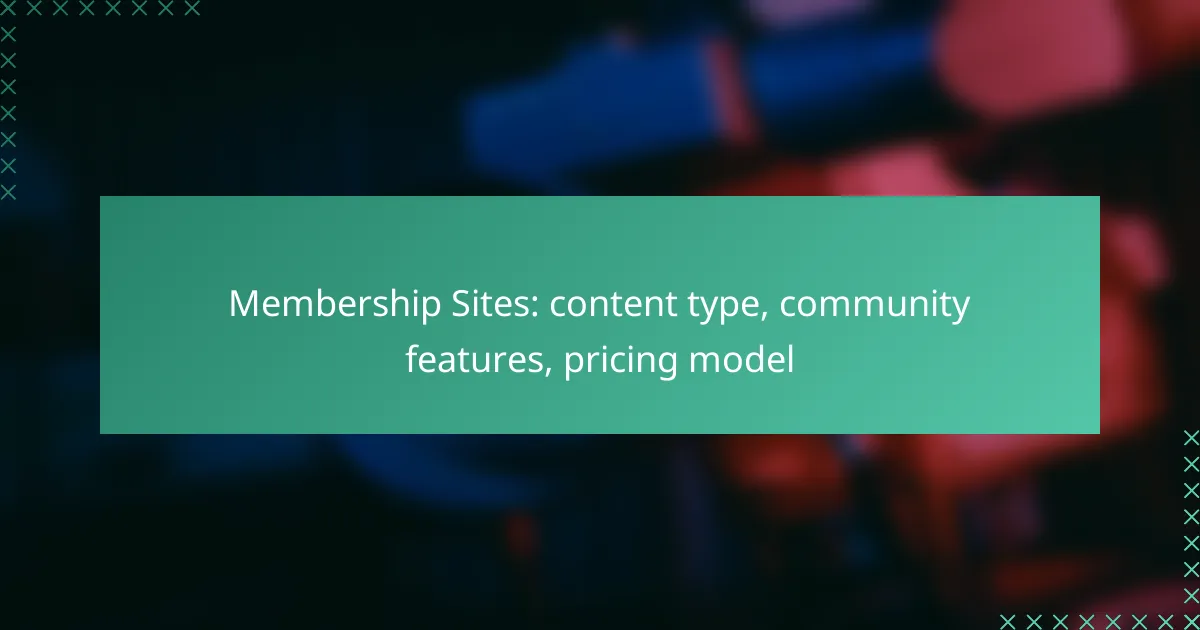Membership sites are designed to deliver valuable content and foster community engagement, making them an essential tool for various organizations. By offering diverse content types and interactive features, these platforms encourage member participation and create a sense of belonging. Additionally, flexible pricing models allow for tailored access, ensuring that the needs of different audiences are met effectively.

What are the best membership site platforms in the UK?
The best membership site platforms in the UK offer a range of features tailored for content delivery, community engagement, and pricing flexibility. These platforms cater to various needs, from educational content to community-building, making it essential to choose one that aligns with your goals.
MemberPress
MemberPress is a powerful WordPress plugin that allows you to create and manage membership sites easily. It offers features like content protection, subscription management, and integration with various payment gateways, making it suitable for those who want to monetize their content effectively.
Consider using MemberPress if you already have a WordPress site, as it seamlessly integrates with it. Pricing starts at around £149 per year, which includes essential features, but you may need to upgrade for advanced functionalities.
Teachable
Teachable is primarily an online course platform that also supports membership features. It allows creators to build courses and offer memberships, making it ideal for educators and trainers. You can set up subscription plans, create quizzes, and track student progress.
Teachable’s pricing begins at approximately £29 per month, with higher tiers offering advanced marketing tools and customization options. This platform is particularly beneficial for those focused on educational content and community interaction.
Thinkific
Thinkific is another robust platform for creating and selling online courses, with membership capabilities. It provides tools for course creation, membership management, and student engagement, allowing you to build a community around your content.
With Thinkific, you can start for free, but paid plans range from about £39 to £119 per month, depending on the features you need. This flexibility makes it a great choice for both beginners and established creators.
Podia
Podia is an all-in-one platform that supports online courses, digital downloads, and memberships. It focuses on simplicity and user experience, making it easy to set up and manage your offerings. Podia also includes email marketing tools to help you engage with your audience.
Pricing for Podia starts at around £29 per month, which includes essential features for selling memberships and courses. This platform is ideal for creators looking for a straightforward solution without technical hassles.
Kajabi
Kajabi is a comprehensive platform designed for online courses and membership sites, offering advanced marketing tools and automation features. It allows you to create a professional-looking site with minimal effort, making it suitable for those who want a polished online presence.
However, Kajabi’s pricing is on the higher side, starting at approximately £119 per month. This investment may be worthwhile for serious entrepreneurs looking to scale their membership offerings and leverage extensive marketing capabilities.

What content types are effective for membership sites?
Effective content types for membership sites include engaging formats that provide value and foster community. These can range from educational resources to interactive features that encourage member participation.
Video tutorials
Video tutorials are a popular content type for membership sites, offering visual and auditory learning experiences. They can cover a variety of topics, from skill-building to product usage, and typically range from a few minutes to an hour in length.
To maximize engagement, ensure videos are well-produced and include clear instructions. Consider breaking longer tutorials into shorter segments to maintain viewer interest.
Exclusive articles
Exclusive articles provide in-depth insights and valuable information tailored to your audience’s interests. These articles can cover industry trends, expert interviews, or how-to guides that are not available to non-members.
Regularly updating your article library keeps content fresh and encourages members to return. Aim for a mix of short, digestible pieces and longer, comprehensive articles to cater to different reading preferences.
Webinars
Webinars allow for real-time interaction between experts and members, making them an effective way to deliver content. They typically last from 30 minutes to over an hour and can include Q&A sessions to engage participants.
To enhance the experience, promote upcoming webinars in advance and provide recordings for those who cannot attend live. This approach increases accessibility and adds value to the membership.
Downloadable resources
Downloadable resources such as eBooks, templates, and checklists are valuable tools that members can use offline. These resources should be relevant to the interests of your audience and provide practical assistance.
Consider offering a variety of formats to cater to different preferences. Regularly refresh your offerings to keep members engaged and encourage them to utilize these resources in their daily activities.
Community forums
Community forums foster interaction among members, allowing them to share experiences, ask questions, and provide support. This type of content builds a sense of belonging and encourages ongoing participation.
To maintain an active forum, establish clear guidelines for engagement and moderate discussions to ensure a positive environment. Regularly highlight popular threads or member contributions to encourage further interaction.

How do community features enhance membership sites?
Community features significantly enhance membership sites by fostering engagement and interaction among members. These elements create a sense of belonging and encourage users to participate actively, which can lead to higher retention rates and satisfaction.
Member interaction
Member interaction is crucial for building a vibrant community within a membership site. Features such as forums, chat rooms, and comment sections allow users to share ideas, ask questions, and provide support to one another. This interaction not only strengthens relationships but also enriches the content through diverse perspectives.
To maximize member interaction, consider implementing user-friendly interfaces and moderation tools to maintain a positive environment. Regular prompts for discussion or themed topics can also stimulate engagement.
Feedback mechanisms
Feedback mechanisms enable members to share their thoughts on content and community features, which can guide improvements. Surveys, polls, and suggestion boxes are effective tools for gathering insights and understanding member needs. This feedback loop helps in tailoring the membership experience to better serve the audience.
Encouraging feedback should be a continuous process. Consider offering incentives, such as discounts or exclusive content, to motivate members to participate in surveys and provide honest opinions.
Networking opportunities
Networking opportunities are a key benefit of community features in membership sites, allowing members to connect with like-minded individuals. This can lead to collaborations, partnerships, and even friendships that extend beyond the platform. Features like member directories or interest-based groups can facilitate these connections.
To enhance networking, organize virtual meetups or webinars where members can interact in real-time. Providing structured networking events can help members make meaningful connections.
Event scheduling
Event scheduling features allow members to participate in organized activities, enhancing community engagement. Tools for creating and managing events, such as calendars and RSVP systems, help streamline participation. These events can range from webinars and workshops to social gatherings.
When implementing event scheduling, ensure that the process is straightforward and accessible. Regularly update members about upcoming events and consider varying the times to accommodate different time zones, especially for international members.

What pricing models are common for membership sites?
Common pricing models for membership sites include monthly subscriptions, annual memberships, one-time fees, and tiered pricing. Each model has its own advantages and considerations, allowing site owners to choose what best aligns with their audience and content strategy.
Monthly subscriptions
Monthly subscriptions charge members a recurring fee each month, providing consistent revenue for the site owner. This model is appealing for users who prefer lower upfront costs and the flexibility to cancel at any time.
When implementing monthly subscriptions, consider offering a free trial to attract new members. However, be mindful of retention strategies, as churn rates can be high if users do not find ongoing value.
Annual memberships
Annual memberships require users to pay a lump sum for a full year of access, often at a discounted rate compared to monthly payments. This model can enhance cash flow and improve member commitment, as users are less likely to cancel mid-year.
To incentivize annual memberships, consider offering exclusive content or bonuses for long-term members. This can create a sense of loyalty and increase the perceived value of the membership.
One-time fees
One-time fees grant users access to content or features without ongoing payments. This model is suitable for sites offering specific courses, workshops, or downloadable resources.
While one-time fees can simplify the purchasing process, they may limit long-term revenue potential. Ensure that the content provided justifies the price and consider upselling additional products or services.
Tiered pricing
Tiered pricing offers multiple membership levels at different price points, each with varying benefits. This model allows users to choose a plan that best fits their needs and budget, potentially increasing overall membership numbers.
When designing tiered pricing, clearly outline the benefits of each level to help users make informed decisions. Avoid overwhelming potential members with too many options, as this can lead to decision fatigue.
